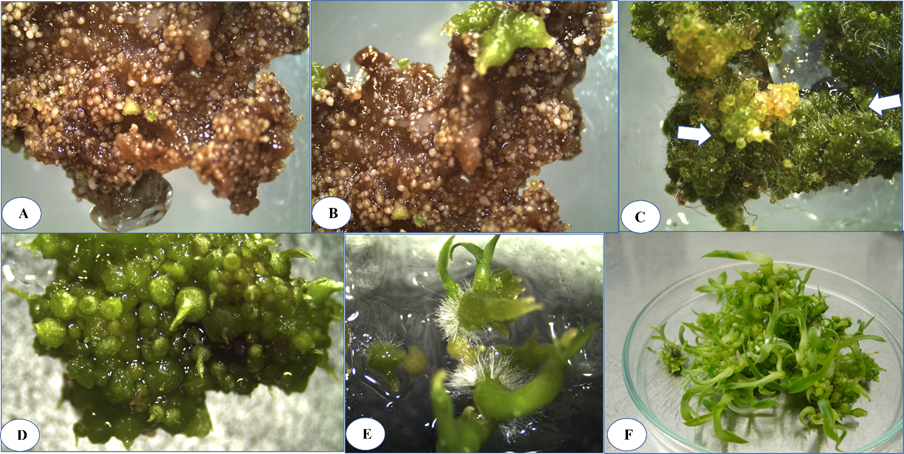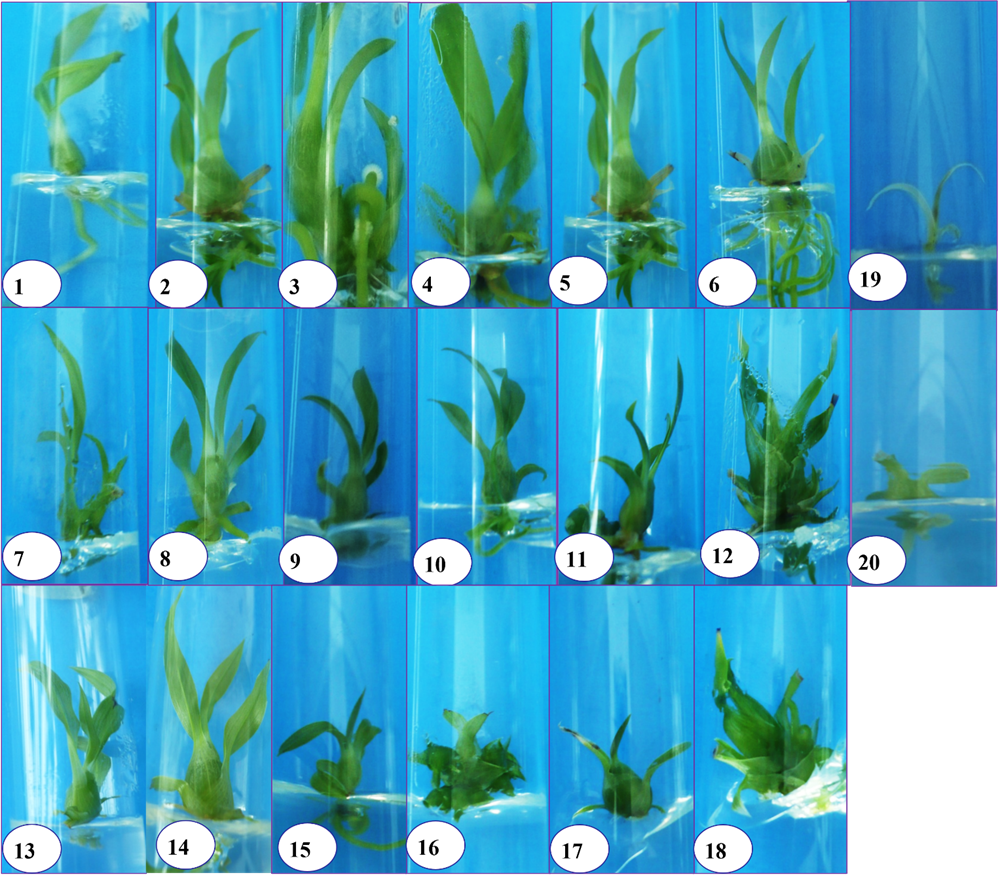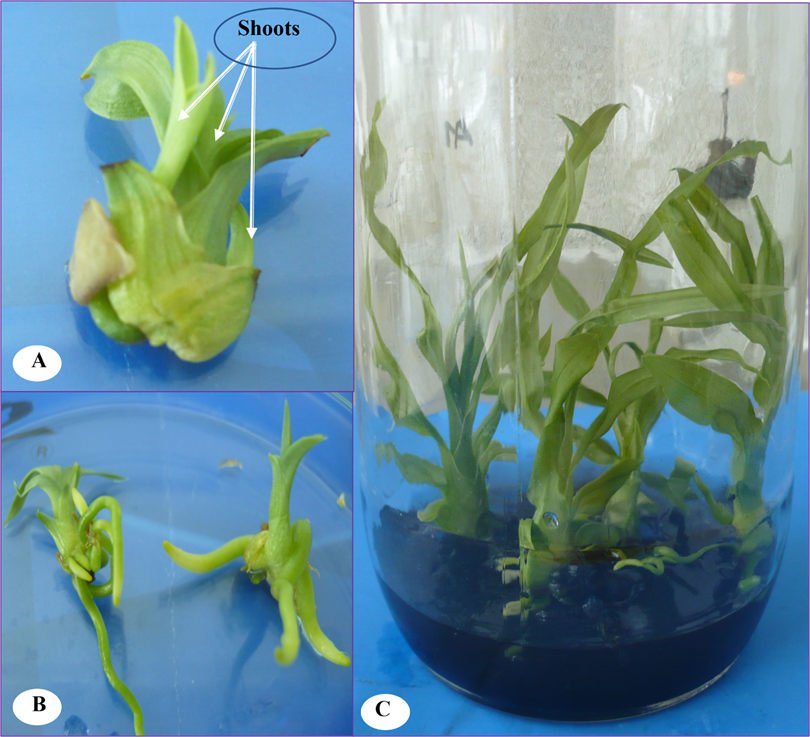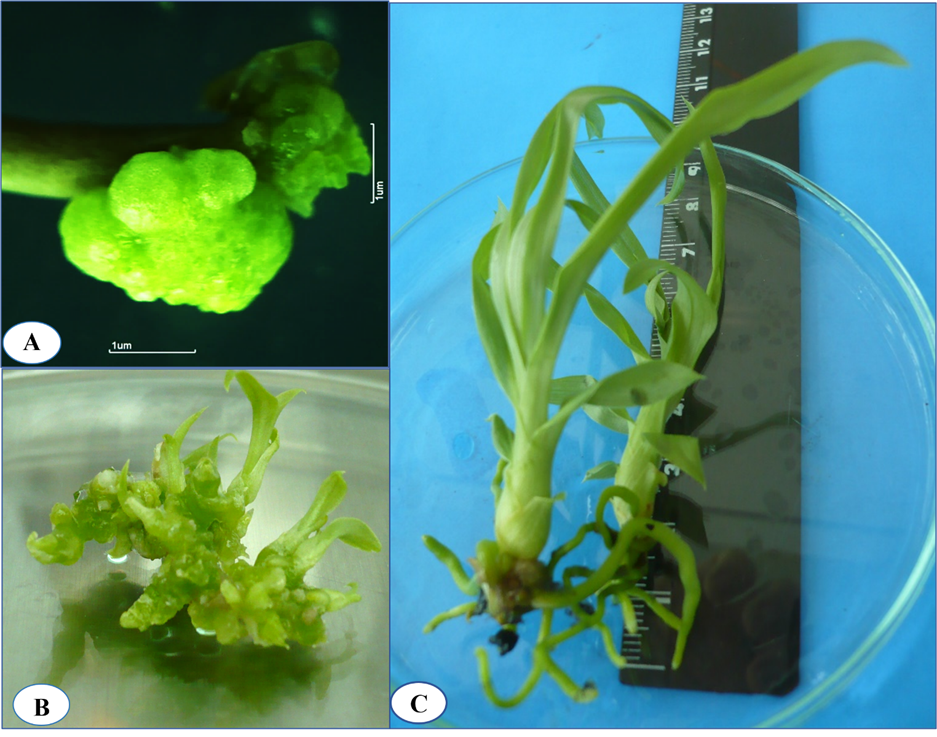Introduction
Orchidaceae is one of the largest families of flowering plants (Pérez Gutiérrez, 2010; Noguera-Savelli & Cetzal-Ix, 2014), which are part of complex biological interactions of ecosystems (Seaton et al., 2013; Pereira et al., 2015). Orchids are also considered an important crop in the floriculture industry. This plant family is usually cultured due to its medicinal properties and uses in traditional food, as well as the generation of nutraceutical products, perfumes, and cosmetics (Hinsley et al., 2018; Kanlayavattanakul et al., 2018; Salazar-Mercado & Botello-Delgado, 2020; Singh et al., 2021). In recent years, many species of orchids have been threatened in their natural habitats because of the environmental pressure generated by humans (Juras et al., 2020; Fonseka, 2020; Puspitaningtyas & Handini, 2020). C. integerrimum is an orchid that reaches to adult stage in approximately two years. This development stage is less than 50 percent of the time required by most of the not deciduous taxa orchids (Benzing et al., 1982). This species lives in Guatemala, Belize, Honduras, El Salvador, Nicaragua and Mexico (Morales-Báez et al., 2016). C. integerrimum is an ornamental plant whose flowers are very showy and attractive that produce a fragrance compound by pinene (32.52%) and carvone oxide (46.21%) (del Mazo Cancino & Damon, 2007). It is often collected, resulting in a decrease in the population of their natural habitat (Morales-Báez et al., 2016). This over-exploitation generates a loss of their population. Moreover, germination in a natural environment entirely depends on the mycorrhizal fungi association (Pérez Gutiérrez, 2010). This association provides water, carbohydrates, minerals, and vitamins for embryos development; however, mortality rates of embryos developed are high despite this association (Kauth et al., 2006). Asymbiotic seed propagation, which is an excellent method for the micropropagation of orchids for conservation purposes (Kim et al., 2021). Asymbiotic germination of orchid seeds was established by Lewis Knudson (1884-1958), and it was the first practical procedure for in vitro propagation of any plant in pure (i.e., axenic) culture (Yam & Arditti, 2009). Since then, many ornamental species of orchids have been micropropagated using this method (Pereira et al., 2017; Vudala & Ribas, 2017; Acemi & Özen, 2019; Franceschi et al., 2019; Koene et al., 2019; Fonseka, 2020; Kang et al., 2020; Salazar-Mercado & Botello-Delgado, 2020; Sorgato et al., 2020;. Chin et al., 2021;Kim et al., 2021; Navarro et al., 2021; Yeh et al., 2021); The asymbiotic germination process generates protocorm-like-bodies (PLBs) which are embryogenic structures (Chin et al., 2021). The process goes from stage 0: No germination to stage 5: the differentiation (Yamazaki & Miyoshi, 2006).
Due to the conservation of the germplasm of this species is needed, in vitro culture techniques have been successfully applied for conservation. Also, it facilitates the availability of germplasm for use in genetic improvement programs (Arrigoni-Blank et al., 2014).
One of the methods used is slow growth, which reduces plant metabolism and consequently decelerates its development, which allows the maintenance of in vitro plant collections without the need for subculture (Chauhan et al., 2019; Santos Lima et al., 2021; Petrova et al., 2021). The slow growth procedure is called medium-term conservation or minimal growth storage (Muñoz et al., 2019).
The advantage of the slow growth technique is that enabling in vitro maintenance of shoot cultures under aseptic conditions by markedly reducing the frequency of periodic subculturing without affecting the viability and regrowth potential of such shoot cultures (Koeda et al., 2018). The slow growth can be achieved by basal culture medium modification, sucrose, and plant growth regulators (PGRs) concentration changes (Ruta et al., 2020). Other substances used to slow growth are mannitol and sorbitol (da Costa Santos et al., 2011; Tavazza et al., 2015; Hammond Hammond et al., 2019; Muñoz et al., 2019; Petrova et al., 2021;). Furthermore, reports of slow-growth techniques include protocols for conserved material multiplication (Hammond-Hammond et al., 2019; Ramírez-Mosqueda et al., 2019; Fonseka, 2020).
The present study describes the asymbiotic germination of C. integerrimum, its conservation in a slow-growth medium and the regeneration by direct and indirect adventitious organogenesis.
Material and methods
Obtaining plant material
Fully closed of C. integerrimum from two capsules with good condition were collected from experimental field El Tormento, Campeche, Mexico at the "Instituto Nacional de Investigaciones Forestales Agrícolas y Pecuarias (INIFAP)". Afterward, the capsules collected were transferred to the laboratory and put inside a desiccator with 1 kg of silica gel at 25±2ºC for five days. Then they were washed with a solution of Extran® at 5% for 5 minutes and rinsed three times with sterile distillate water.
In vitro establishment of plant material
The capsules were disinfected in a laminar flow cabinet by immersion in a solution of sodium hypochlorite at 1% with 10 µL of Extran® for 10 min, then were rinsed three times with distilled water, afterward were atomized with 70% of ethanol and flamed with a burner. The capsules sterilized were longitudinally cut with a scalpel to obtain the seeds, which were put on a sterile Petri dish. Finally, 300 seeds were cultured in Magenta® boxes with treatments for asymbiotic germination.
Asymbiotic germination
Semi-solid media of MS medium with macro-micro nutrients and vitamins (M5519 SIGMA®), MS medium with macro-micro nutrients (M5524 SIGMA®), Orchid Medium with charcoal and Banana Powder (P1056 SIGMA®), and Knudson C (K4003 SIGMA®) were used to investigate the asymbiotic germination of C. integerrimum without PGRs. The pH of the media was adjusted at 5.8 before sterilizing in an autoclave at 121°C. The treatments were dosed at 25 mL per Magenta® box, and seeds were established in three Magenta® boxes per treatment. The evaluation was carried out every 4 weeks for 16 weeks, recording data and digital pictures.
Slow growth for in vitro conservation
Plantlets of 2 cm from asymbiotic germination were established in a factorial experiment of 2 x 3 x 3 for conservation. The first factor was the concentration of basal medium (Full and half ionic strength), the second factor was the carbon source (sorbitol, mannitol, and sucrose), and the third factor was the concentration of carbon source (1, 2, and 3%). The experiment was carried out with two MS basal medium control: half-strength MS basal medium (2.2 g L-1) and full-strength MS basal medium (4.4 g L-1) without carbon source. In total were evaluated 18 treatments with two controls and three replicates per treatment. Treatments with half-strength MS basal medium were solidified with 3.1 g L-1 of Gelrite® and the treatments with full strength MS basal medium with 2.2 g L-1 of Gelrite®. The variables evaluated were the plantlet growth and the shoots number formed per treatment. Plant growth was obtained by subtracting the plantlet length (mm) at six months of culture from plantlet length at the beginning of culture. The result was the plantlet growing after six months of culture. The shoots number formed per treatment was recorded at 12 months.
Plant regeneration
Induction of regeneration was evaluated in a factorial design of 3 x 2 x 3, which the first factor was the explant source (node, leaf, and root), the second factor was kinetin or BAP, and the third factor PGR concentration, kinetin at 4.64, 9.29 and 23.2 µM, and BAP at 4.43, 8.87 and 22.2 µM. The experiment had 18 treatments and one control with three replicates per treatment. The control was the MS basal medium without PGRs. All treatments were formulated with full strength MS basal medium added with 3% sucrose and 2.2g L-1 of Gelrite®. The variable evaluated was shoot number per explant at the 60 days, and shoots were allowed to grow until 120 days of culture. All treatments were supplemented with 2 g L-1 of activated carbon.
In vitro culture conditions
All treatments were incubated at 23±2°C and relative humidity of 60% with a photoperiod of 16/8 hours (light/darkness); the light source was provided by LED lamps with a light intensity of 60 μmol-2s-1.
Statistical analysis
Data were subjected to one-way ANOVA analysis of variance for comparison of means. Significant differences were calculated according to the Tukey test at the 5% significance level using a statistical Statgraphics® Centurion XVI statistical software. Data were presented as means ± standard error.
Results
Asymbiotic germination
Asymbiotic germination of seeds of C. integerrimum occurred in basal MS medium with macro and micronutrients without vitamins, 250 plantlets were obtained. At four weeks after sowing, the seeds formed a brown friable callous mass jelly-like, from which white embryogenic structures emerged (WES) (Fig. 1 A). At six weeks, the WES began to grow into PLBs that turned green. (Fig. 1 B). Root formation in PLBs (Fig. 1 C) and shoot differentiation into PLBs from protocorms (Fig. 1 D) occurred at 8 and 10 weeks, respectively. The plantlets formed rootlets and leaves at 12 weeks (Fig. 1 E). The same basal medium where germination occurred completed growth up to 16 weeks and reseeding was unnecessary during this process (Fig. 1 F). C. integerrimum seeds sown on basal MS media with macro and micronutrients and vitamins, Orchid Medium with Charcoal and Banana Powder and Knudson had no germination response.

Fig. 1 Asymbiotic seed germination of C. integerrimum. Callus with embryogenic structures (A); Embryogenic structures transforming into PLBs (B); Rhizoids formed on the protocorm (white arrows) (C); Shoots differentiated from the protocorm (D); Plantlets formed 3 months after sowing seeds (E); Fully developed plantlets at four months of age (F).
Slow growth for in vitro conservation
There was significant difference among the 20 treatments selected to evaluate the growth of C. integerrimum plantlets (Table 1). T3 allows the highest growth value (76.24±30.5) followed by T1 (54.74±7.6), T5 (52.69±20.1), T4 (48.32±15.8), and T2 (37.39 ±3.7) (Table 1, Fig. 1). The treatments with the lowest growth values of cultivated plantlets were T19 (8.54±5.2), T20 (13.10±5.3), T17 (14.18±6.1), T18 (17.70±5.8), T16 (18.61±4.0), T10 (19.71±2.6) and T11 (21.07±8.6), there was no significant difference among these seven treatments (Table 1), the controls T19 and T20 showed the lowest growth values, the leaves of the plantlets showed etiolation and died. Treatment T17 was selected because it presented the lowest value of growth in plantlet length among the other treatments. The plantlets from T17 did not show changes in plant morphology. At six months the shoot formation in the slow growth treatments was evaluated. The treatment T3 (Table 1) formed the highest number of shoots (28.4± 3.2). On the other hand, T17 showed the lowest shoot formation (1±00).
Table 1 Effect of culture medium composition on plantlets growth and shoot proliferation of C. integerrimum Hook. to determine the best treatment for in vitro conservation
| Treatment | MS concentration (%) |
Carbon source |
Carbon concentration (%) |
Average of plantlet length (mm) |
No. Shoot per treatment |
|---|---|---|---|---|---|
| 1 | 100 | Sucrose | 1 | 54.74±7.6h | 9.20±2.2c |
| 2 | 2 | 37.39±3.7fg | 17.60±2.7e | ||
| 3 | 3 | 76.24±30.5j | 28.40±3.2f | ||
| 4 | 50 | Sucrose | 1 | 48.32±15.8gh | 12.60±1.9cd |
| 5 | 2 | 52.69±20.1h | 14.40±2.3de | ||
| 6 | 3 | 26.84±8.8cdef | 5.40±1.3b | ||
| 7 | 100 | Mannitol | 1 | 31.95±13.1ef | 3.40±1.1ab |
| 8 | 2 | 32.26±6.0ef | 2.60±0.8ab | ||
| 9 | 3 | 24.23±4.5bcdef | 2.20±0.4ab | ||
| 10 | 50 | Mannitol | 1 | 19.71±2.6abcde | 2.40±0.5ab |
| 11 | 2 | 21.07±8.6abcde | 3.40±1.1ab | ||
| 12 | 3 | 31.57±7.4ef | 3.20±1.7ab | ||
| 13 | 100 | Sorbitol | 1 | 29.31±5.1def | 2.60±0.8ab |
| 14 | 2 | 30.14±3.98def | 2.80±1.3ab | ||
| 15 | 3 | 27.51±8.7cdef | 2.60±0.5ab | ||
| 16 | 50 | Sorbitol | 1 | 18.61±4.0abcde | 2.60±1.8ab |
| 17 | 2 | 14.18±6.1abc | 1.00±0.0ab | ||
| 18 | 3 | 17.70±5.8abcd | 3.20±1.3b | ||
| 19 | 100 | None | 0 | 8.540±5.2a | 0.00±0.0a |
| 20 | 50 | None | 0 | 13.10±5.3ab | 0.00±0.0a |
Different letters indicate significant statistical differences according Tukey test (P ≤ 0.05). MS: Murashige and Skoog basal medium.
Plant regeneration
The type of explant influenced shoot formation (Table 2). The leaf explant did not show regeneration. Shoot induction from node explant of C. integerrimum via direct organogenesis occurred at 30 days (Fig. 3 A) on treatments T2-T7. There was no significant statistical difference among treatments; T5, T16, and T17 showed 3.0 adventitious shoots per explant, followed by T3 with 2.5 shoots (Table 2). Rooting of shoots was observed in the same induction medium; the plantlets morphology at 60 and 120 days was normal (Fig. 3 B-C).
Table 2 Effect of PGR and type of explant on the induction of adventitious organogenesis of C. integerrimum Hook.
| Treatment | Explant | PGR |
PGR Concentration (µM) |
# adventitious shoots/explant |
|---|---|---|---|---|
| 1 | Node | None | 0.00 | 0.00±0.00a |
| 2 | Kinetin | 4.64 | 2.25±1.20b | |
| 3 | 9.29 | 2.50±1.20b | ||
| 4 | 23.2 | 2.25±1.50b | ||
| 5 | BAP | 4.43 | 3.00±0.81b | |
| 6 | 8.87 | 2.00±1.15b | ||
| 7 | 22.2 | 1.75±0.50b | ||
| 8 | Leaf | None | 0.00 | 0.00±0.00a |
| 9 | Kinetin | 4.64 | 0.00±0.00a | |
| 10 | 9.29 | 0.00±0.00a | ||
| 11 | 23.2 | 0.00±0.00a | ||
| 12 | BAP | 4.43 | 0.00±0.00a | |
| 13 | 8.87 | 0.00±0.00a | ||
| 14 | 22.2 | 0.00±0.00a | ||
| 15 | Root | None | 0.00 | 0.00±0.00a |
| 16 | Kinetin | 4.64 | 3.00±0.81b | |
| 17 | 9.29 | 3.00±0.00b | ||
| 18 | 23.2 | 0.00±0.00a | ||
| 19 | BAP | 4.43 | 0.00±0.00a | |
| 20 | 8.87 | 0.00±0.00a | ||
| 21 | 22.2 | 0.00±0.00a |
Different letters indicate significant statistical differences according Tukey test (P ≤ 0.05). PGR: Plant Growth Regulator, BAP: Benzyl Amino Purine. MS: Murashige and Skoog basal medium.

Fig. 2 In vitro conservation of C. integerrimum growth after 6 months of cultivation in treatments evaluated for its conservation. Full strength MS basal medium supplemented with sucrose 1, 2, and 3%: (1), (2), and (3) respectively. Half strength MS basal medium with sucrose 1, 2, and 3%: (4), (5), and (6) respectively. Full strength MS basal medium supplemented with mannitol 1, 2, and 3%: (7), (8), and (9) respectively. Half strength MS basal medium with mannitol 1, 2, and 3%: (10), (11), and (12) respectively. Full strength MS basal medium supplemented with sorbitol 1, 2, and 3%: (13), (14), and (15) respectively. Half strength MS basal medium supplemented with sorbitol 1, 2, and 3%: (16), (17), and (18) respectively. Controls: half-strength MS basal medium without carbon source (19) and full-strength MS basal medium without carbon source (20).

Fig. 3 Direct adventitious organogenesis from node explant of C. integerrimum. Adventitious shoots from node explant on full strength MS basal medium+ BAP at 4.43 µM, 30 days culture (A); Plantlets at 60 days of culture (B); Plantlets at 120 days of culture (C).
The root explant formed callus after 30 days of cultivation in full strength MS basal medium supplemented with kinetin at 4.64 or 9.29 µM (Fig. 4 A). Indirect shoot organogenesis at 60 days of culture (Fig. 4 B), the rooting of shoots occurred in the same induction medium. Plantlets showed an average height of 8 cm after 120 days of cultivation. (Fig. 4 C). BAP did not induce organogenesis in root explant (Table 2).
Discussion
Tissue culture methods are an alternative for help in the rescue of species endangered by deforestation and unmeasured extraction from their natural habitat. This study presents asymbiotic germination, conservation, and in vitro regeneration of C. integerrimum that have not been previously reported.
The germination of orchid seeds in their natural habitat is complex and inefficient because there must be a symbiotic relationship with a fungus. Association between orchids and fungi was observed in 1824 (Yam & Arditti, 2009). On the other hand, in vitro germination is efficient when the composition of the culture medium is known.
According to the classification described by (Yam & Arditti, 2009), the stages of "pre-germination," "germination," and "protocorms formation" corresponding to stages 1-3 were not visible in this study. This observation could be due to the seeds cultivated on MS basal medium with macro and micronutrients without vitamins formed callus. Furthermore, white embryogenic structures formed from the callus, becoming PLBs, the stages 4 and 5 were clearly visible. Full strength MS basal medium including all macro and micronutrients, without vitamins, was the only one of the four media evaluated that gave a response to asymbiotic germination of C. integerrimum. Unlike reports of asymbiotic germination using MS medium with half of the macro and micronutrients (Koene et al., 2019; Kang et al., 2020; Yeh et al., 2021; Navarro et al., 2021; Kim et al., 2021). In vitro culture conditions and the lack of vitamins in the MS basal medium may have generated stress in the C. integerrimum seed culture, triggering a signaling cascade for dedifferentiation leading to callus formation. It is going by concepts reported by Fehér (2014) that differentiated plant cells, under certain circumstances, can revert to an earlier developmental state and regain totipotency.
Mineral nutrition, vitamins, and medium composition influence asymbiotic seed germination have been reported (Salazar-Mercado & Botello-Delgado, 2020; Kim et al., 2021). Other formulations have been necessary, for instance: New Dogashima medium was used for germination of mature seeds of Calanthe tricarinata (Godo et al., 2010) or Woody plant medium (WPM) (Vudala & Ribas, 2017; Franceschi et al., 2019); Vacin and Went medium (VW) (Pereira et al., 2017; Utami & Hariyanto, 2019; Acemi & Özen, 2019). New Dogashima medium has microelements and organic compounds of Nitsch and Morel respectively, NH4NO3 and KNO3 are in minor amount in comparison with MS, this media was developed for micropropagation of orchids (Tokuhara et al., 1993). On the other hand, Woody Plant Medium contains the macro-micronutrients and vitamins described by Phillips & Garda (2019).
In this study C. integerrimum exogen PGRs were not necessary during the asymbiotic germination and plantlet development contrary to other protocols reported, asymbiotic germination of Calanthe tricarinata Lindl occurred using the basal medium New Dogashima with BAP or α-naphthalene acetic acid (NAA) (Godo et al., 2010); On the other hand, the germination of C. integerrimum was achieved using full-strength MS basal medium added with 2% BAP; in the same study the protocorms development was necessary to use full strength MS basal medium added with 5 mg L-1 of activated charcoal and indole acetic acid (IAA) at 5 mg L-1 (Velázquez Kú et al., 2016).
The conservation protocols for Dendrobium draconis, Bulbophyllum auricomum Lindl., Ullucus tuberous species of the subfamily Epidendroideae, Arnica montana L. used MS reduced to half its ionic strength as basal medium (Than, 2013; Hammond Hammond et al., 2019; Menezes-Sá et al., 2019; Petrova et al., 2021).
Other basal media used in preservation protocols include Vacin and Went (Puspitaningtyas & Handini, 2020). The woody plant medium (WPM) (Matos Alvim et al., 2020). Culture media for slow growth can use sucrose as a carbon source (Than, 2013; Sanghamitra et al., 2019; Menezes-Sá et al., 2019; El-Hawaz et al., 2019; Matos Alvim et al., 2020; Gomes et al., 2021). Another modification made to the culture medium is sorbitol and mannitol as carbon sources. The use of mannitol on slow growth protocols has been reported for Globe artichoke, Ullucus tuberosus (Tavazza et al., 2015; Hammond Hammond et al., 2019). On the other hand, the combined effect of mannitol and sucrose allowed the conservation of Amburana cearensis plants with better characteristics than using sucrose alone (Matos Alvim et al., 2020). The results showed that C. integerrimum plantlets have higher growth in treatments T1-T5 supplemented with sucrose, even inducing multiple sprouting, so they are recommended for propagation but not for slow growth. T17 treatment formulated with half-strength MS basal medium and 2% sorbitol was selected for in vitro conservation of C. integerrimum. The use of sorbitol to slow growth rate has been reported in Hancornia speciosa Gomes; Arnica montana L., Solanum tuberosum (da Costa Santos et al., 2011; Muñoz et al., 2019; Petrova et al., 2021);. The combination of sorbitol with sucrose preserves in vitro plants of Solanum tuberosum without phenotypic abnormalities (Nasiruddin & Rafiul Islam, 2018). The combination of sorbitol with sucrose and mannitol with sucrose allows slow growth storage of potato germplasm (Muñoz et al., 2019).
In this study, kinetin induced the regeneration of adventitious shoots from root explants, and BAP induced a similar response from node explants. Kinetin induces callus (clusters of dedifferentiated plant cells) to differentiate into adventitious buds (Barciszewski et al., 2007; Sianipar & Mariska, 2020; Sharma et al., 2021).
Conclusions
Asymbiotic germination, in vitro conservation, and adventitious shoots regeneration of C. integerrimum are methods effective and efficient. It is also important to highlight that the in vitro conservation protocol has been so effective that it has maintained this species in vitro conservation for ten years. The asymbiotic germination method and the regeneration method can be used for propagation, helping to reduce the collection of this species in its habitat.











 nueva página del texto (beta)
nueva página del texto (beta)



